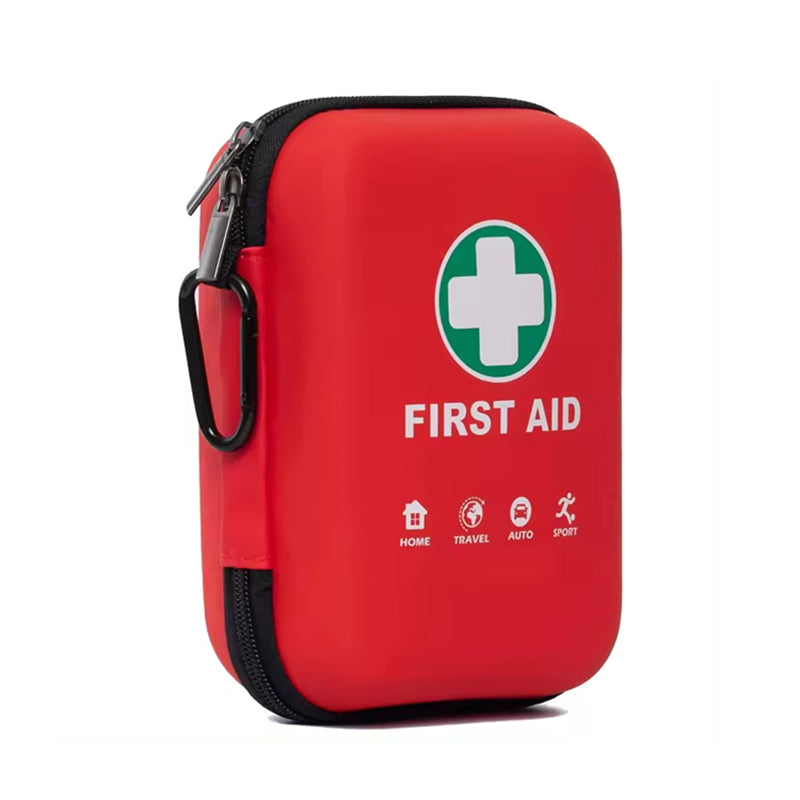Analysis of EVA First Aid Kit Materials

A first aid kit is an essential tool for ensuring safety in daily life. EVA first aid kits have gained popularity due to their unique properties.
Today, let's explore the differences in outer fabric, lining, and EVA hardness, as well as their respective application scenarios, to help you choose the most suitable first aid kit.
Choosing the Outer Fabric
The outer fabric of an EVA first aid kit plays a crucial role in protecting the contents from external elements while ensuring durability and convenience.
Common materials include PVC, Oxford fabric, and polyester, each offering distinct properties and suited for different needs.
PVC (Polyvinyl Chloride)
PVC stands out for its excellent waterproof capabilities, effectively keeping moisture from rain and dew away from the kit's contents. Additionally, PVC costs less and can be easily molded into various shapes and sizes.
However, PVC has its downsides, including lower environmental sustainability since it takes longer to degrade. Under extreme conditions, PVC may also wear out faster compared to more advanced fabrics.
Oxford Fabric
Oxford fabric is a highly durable and versatile material, known for its outstanding resistance to wear and tear. Even with extended use and friction, it maintains its integrity without easily wearing out.
The soft texture makes carrying the first aid kit more comfortable, reducing unnecessary strain. Moreover, Oxford fabric offers some water resistance, protecting the kit’s contents in light rain or short periods of humidity.
Users seeking high durability and premium quality will find Oxford fabric a great option.
Polyester
Polyester is another widely used outer fabric, valued for its strength and elasticity. It resists significant pulling force and pressure without losing its shape.
Additionally, polyester withstands chemical exposure and harsh weather conditions while retaining its performance. The fabric also holds color well, ensuring the first aid kit remains vibrant over time.
However, polyester has lower breathability, which may lead to increased internal temperatures with prolonged use.
For premium markets, eco-friendly and tear-resistant materials enhance both durability and value.
Some modern first aid kits use sustainable materials that outperform traditional fabrics, appealing to consumers who prioritize environmental consciousness.
Lining Material Analysis
The lining of a first aid kit directly interacts with both the emergency supplies and the user, making material selection crucial. Common options include nylon and polyester fabric, each offering distinct advantages.
Nylon
Nylon, a synthetic fiber, delivers exceptional durability and strength, preventing emergency items from excessive friction that could cause damage. Its smooth texture provides a comfortable feel and avoids irritation to the skin.
Additionally, nylon absorbs moisture effectively, keeping the interior dry and ensuring proper storage conditions for medical supplies.
Polyester Fabric
Polyester fabric is a cost-effective yet high-performing lining material. Its soft, smooth texture enhances comfort, while its affordability makes it a practical choice.
The fabric’s wrinkle-resistant nature keeps the first aid kit neat and well-maintained, even after frequent folding and use.
A high-quality lining enhances both protection and convenience. It secures emergency supplies, minimizing movement and impact, thus preserving their integrity.
A well-designed lining also improves user experience by making the kit more comfortable to carry and use.
EVA Hardness Analysis
EVA (Ethylene-Vinyl Acetate) forms the structural foundation of a first aid kit, influencing its stability and shape. The appropriate EVA hardness depends on specific application needs.
Hard EVA
Hard EVA provides superior protection by withstanding high pressure and impacts, ensuring the safety of emergency supplies.
Industrial and high-risk environments, such as construction sites and factories, benefit from hard EVA first aid kits, as they endure heavy loads and collisions. However, harder EVA reduces flexibility, making it less convenient to carry and slightly heavier.
Soft EVA
Soft EVA offers greater flexibility and lightweight portability, making it ideal for outdoor activities such as hiking and travel. This type of EVA allows for easy folding and storage, ensuring effortless transport.
In less extreme environments like city biking or park strolls, soft EVA first aid kits meet basic needs effectively. However, they provide less protection, making them unsuitable for fragile medical items that require added security.
Choosing the right EVA hardness depends on the intended usage. High-stability and protective first aid kits work best in outdoor adventures and medical emergencies, often favoring harder EVA.
Meanwhile, lightweight soft EVA first aid kits prove more convenient for daily carry and short trips.
Conclusion
The choice of outer fabric, lining, and EVA hardness in an EVA first aid kit requires careful consideration based on individual needs. Each material and hardness level offers unique benefits, making it essential to select the right combination for specific scenarios.
Whether for outdoor exploration, daily travel, or medical rescue, selecting the appropriate EVA first aid kit enhances safety and efficiency. This article aims to provide deeper insight into EVA first aid kit materials, helping users make informed decisions for reliable protection.
